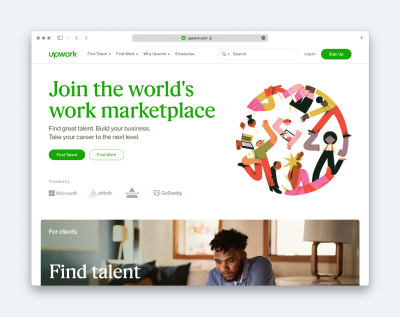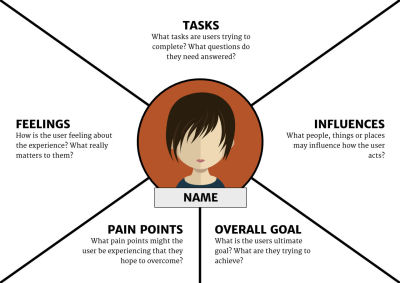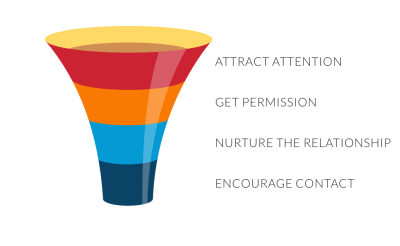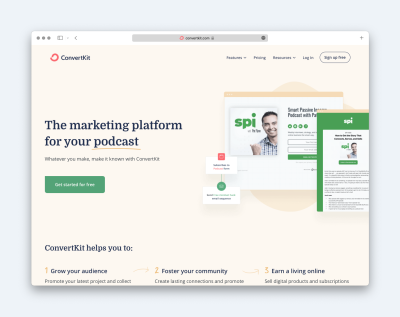A Guide To Attracting Clients To Your Agency
Without a doubt, word-of-mouth recommendation is an incredibly desirable way to win work. It requires zero marketing efforts and typically converts at a higher rate as your agency has been recommended. You should always be seeking to nurture word-of-mouth recommendations, and projects which come this way should make up a significant percentage of your income. However, you should never rely on word of mouth alone.
Word of mouth recommendation suffers from two distinct problems. First, it is a passive approach to marketing the services of your agency. It requires your clients to recommend you, and you can only do so much to encourage that. That means that when work dries up, you can take few active steps to bring in new work.
I encounter far too many agencies that find themselves panicking when the phone stops ringing because they have no mechanism in place to attract new clients.
The second problem with word-of-mouth recommendation is that it tends to attract similar clients. More often than not, those who recommend you do so to people working in similar companies and at a similar level. That is not a hard and fast rule, but this is what I usually see.
That is not a problem as long as you are happy with your clients. However, if you have any ambitions to win bigger or better clients, word of mouth will be a limiting factor.
You will need a way of reaching the specific kind of client you would like to work with, and that needs a strategy that word of mouth cannot supply. Unfortunately, it is just as easy to get that strategy wrong, and doing so can prove a waste of time and money.
The Problem With Traditional Approaches
It is not that most web design agencies are ignorant of other marketing approaches or that any of them are inherently bad. On the contrary, in the second part of his two-part series on getting web design clients, Stephen Roe breaks down the opportunities of these approaches.
The problem is that generally speaking, many struggle to get the returns that justify the investment in time and money. Let’s briefly look at the shortcomings of the many tactics available, starting with cold contacting potential clients.
Cold Contacting
Cold contacting a potential client is almost certainly the most demoralizing kind of marketing you can do. People hate to be contacted out of the blue, so the chances of winning work are poor.

You also need to factor in that your timing has to be perfect. For example, you have to contact somebody when they are considering running a project you can help with; otherwise, they will quickly forget you.
Finally, you have no status in the eyes of the potential client. You are just a random supplier and so are unlikely to grab their attention.
You face a similar problem with advertising.
Advertising
When somebody stumbles across your ad, they don’t know who you are. You haven’t been recommended, and they probably haven’t heard of you through other sources. There is nothing much to make you stand out from the crowd.
In addition, advertising tends to attract smaller clients. That may be appropriate in your situation, but if you seek larger clients, you will find they tend to rely on recommendations and reputation rather than advertising.
Even if larger clients contact you via advertising, they may be including you to make up the numbers. Often, larger companies have procurement rules saying that employees need to go out to multiple suppliers even when they have a preferred one. That means that you could well waste your time tendering for a project with a low chance of success as they already have a preferred supplier.
That is also something that you can find when using a procurement website.
Procurement Sites
Larger organizations often post their invitations to tender on procurement websites. Although responding to these can lead to work, it suffers from the potential issue of you just “making up the numbers.”
Smaller procurement sites like Upwork or Fiverr can also work, but they are highly competitive and price-sensitive in these cases.

Networking
One way to stand out from the crowd and ensure you are in a stronger position when bidding for work is to establish a relationship with the client ahead of time.
Networking is an excellent way of doing this and is a reliable way of finding new work opportunities. The downside of networking is that it is time-consuming and doesn’t scale. That is why many turn to content marketing.
Content Marketing
Content marketing is the primary marketing activity that many digital agencies use, from blogging to social media posts.
On paper, this is a good move. After all, content marketing:
- Should lead to good search engine rankings if well written and targeted;
- Educates clients about best practices;
- Demonstrates to readers your expertise;
- Builds a relationship with your followers at scale;
- Offers the ability to reach a large number of potential clients.
However, in practice, the results can be underwhelming. That is in part due to the success of content marketing. Because it has been so successful, it has become trendy and, as a result, highly competitive.
There is now so much content out there that to get somebody’s attention, let alone rank well on Google, is incredibly hard. Nevertheless, content marketing can still be one of the most effective techniques if it is appropriately focused.
How To Focus Your Marketing
Most agencies that utilize content marketing lack focus in their efforts. They post sporadically on a range of subjects with no consideration of the audience or their needs.
However, if you can rectify that, you will find that content marketing offers the key to a regular stream of potential leads. What is more, you can even decide exactly the kind of clients you want to attract by targeting your marketing efforts.
This targeting involves two steps, the first of which is defining your audience.
Defining Your Audience
Who is it you are trying to reach? Unfortunately, it is a fundamental question that seems to be regularly overlooked by freelancers and agencies as they blog or share content via social media. Too often, they seem to be writing to impress their peers rather than prospective clients.
Instead, picture your ideal client. Are they a small business owner or an employee of a multinational? Are they senior management or a lower-level employee who can influence that manager?
You might want to create an empathy map if that helps or even imagine that your marketing is being created for one of your existing clients you particularly enjoyed working with.

However, don’t stop at the type of person, also think about the sector you want to target.
It is at this point you may start to feel uncomfortable. You might not want to focus on a single sector, and I can understand that.
If you don’t focus your marketing efforts, it will get lost in the ocean of noise online. Focusing it on a particular sector increases the chance of your chosen audience seeing it and of it being relevant to their needs.
Somebody will need to hear about you multiple times before they pay attention, so you need to focus your limited resources on a smaller group of people to ensure that happens.
But let me be clear, I am not suggesting you only do work in your chosen sector. I am only saying you need to focus your initial marketing efforts on a particular sector. You can always focus on another sector further down the line when you get bored, or the work dries up. Most importantly, you will certainly not turn away other work that walks through the door!
I recommend starting with a sector that you have experience in. Also, you are ideally looking for a sector that has some community around it. That is because it will make your audience easier to reach, and with any luck, they will start recommending your content to one another.
“
Once you have defined your audience, the next step is to understand their challenges.
Identifying Your Audience’s Challenges
The harsh truth is that nobody cares about you or your services. What they do care about is overcoming the challenges they face. Therefore, you need to know what those challenges are to position your services as helping address those.
Find out what your audience’s goals are. What are they trying to achieve? Also, find out what pain points they experience? What are they struggling with daily? Talk to existing clients in your chosen sector or consider running a survey.
Once you are confident you understand the goals and pain points, you can understand how your services can help address them. For example, if a marketing manager of a service company is interested in generating more leads, you could position your UX services as encouraging more word-of-mouth recommendations. By contrast, if you are trying to reach a fundraising manager for a charity, you would position those same services as providing a way to encourage regular (rather than one-off) donations.
With a clear picture of your audience and their needs in your mind, now you can turn your attention to building a basic sales funnel.
Building A Simple Sales Funnel
Before we dive into the details of your sales funnel, let’s briefly recap what we need based on the shortcomings of other techniques. We need an approach that will:
- Demonstrate our expertise;
- Help us to stand out from other suppliers;
- Enable us to stay in contact with prospective clients until they are ready to buy;
- Minimize the amount of effort we have to put in over the long term.
To achieve this, we cannot just throw the occasional blog post online or turn up to a networking event once in a while. Instead, we need a structure, and a sales funnel provides that.
We are going to build a straightforward four-step funnel. We are going to:
- Attract the attention of potential clients;
- Get their permission to stay in contact giving us time to build credibility;
- Nurture that relationship until they are in a position to hire us;
- Encourage your audience to contact you.

Our sales funnel will be built around an email course that will show your prospective audience how to overcome their pain points and achieve their goals using the kinds of services we offer. For example, suppose you are trying to reach charity fundraisers, and you offer UX services. In that case, you might want to create a course on how to improve charity fundraising by creating an exceptional user experience.
We are going to make this an email course rather than a series of blog posts because we want people to subscribe to our newsletter. The email course gives us permission to email them periodically to make sure they don’t forget us.
Writing the email course is the hardest part, but not as hard as you might think. I recommend making it about six to eight emails long, and each email only needs to be approximately 800 words. So effectively, you are writing six to eight short blog posts.
If you hate writing, no problem. Make it a video course instead. Just make sure you email each lesson to people, so they have to sign up.
Although creating the email course feels like a lot of work, we can get a lot of value from it at all stages of our sales funnel once it is done.
So with that in mind, let’s look at each step in more depth.
Attract Attention
Step one is to attract the attention of potential clients. To achieve this, we will use all of the traditional marketing techniques we have already discussed:
- Writing posts for your blog, but using keywords that will perform well on our audience’s searches;
- Writing guest posts for blogs that our target audience reads;
- Speaking at the events our target audience attends;
- Creating social media content tagged with appropriate hashtags for our audience;
- Participating in communities our audience is involved in;
- Even paid advertising if you wish.
However, with our approach, there are two significant differences. First, we are only producing content that is focused on our audience and that we are confident should reach them. Second, every piece of content will also promote our email course and drive people to a landing page.
Now I know what you are thinking; this is a lot of work, especially in addition to creating the email course. However, it is not as bad as it appears because all of the above content can essentially be variations on the content we create for the email course.
For example, let’s say one of your email lessons was on using user experience design to improve conversion. You could rehash that into a guest post, social media posts, or even a talk at an industry event. Not only does this save yourself work, but it also ensures that the email course is relevant to the content you are releasing.
With any luck, your audience will see your content and then respond to the call to action. The next step is then to get their permission to maintain contact.
Get Permission To Maintain Contact
Your call to action will be to visit a landing page that explains to your audience what your email course is all about. It will promise your six-to-eight-part course (which I recommend you release weekly) plus a monthly newsletter where you share advice related to your services.
The inclusion of the monthly newsletter is essential; otherwise, subscribers may forget you after completing the course. On the other hand, writing a few hundred words once a month addressing some aspect of your audience’s needs shouldn’t be too demanding. Often it is just diving into one of the subjects in the email course in a bit more depth.
I won’t get into the nuances of landing page design here, but ensure that you focus both on what the email course covers and the benefits it will provide to anybody subscribing. Also, place particular importance on the fact that this email course has been designed for the specific audience you are trying to reach.
Finally, you may wish to encourage subscriptions by offering an additional incentive to people who subscribe on their first visit. For example, you may provide them with a “how to persuade the boss that user experience matters” downloadable guide.
When somebody subscribes, they should immediately receive the first part of the course and then receive subsequent parts every week. Most email marketing platforms will support this kind of functionality, but personally, I use Convertkit.

Once a subscriber has completed their email course, they should be migrated to your monthly newsletter.
Nurture The Relationship
As I have said numerous times in this post, it is essential to maintain contact with prospective clients to ensure they remember you when they need your services. Unfortunately, that may not happen within the six to eight weeks of your email course. Therefore, they need to continue to receive occasional emails from you, so you stay in the front of their mind.
These emails ensure prospective clients remember you and continually reinforce your expertise and credibility by providing valuable advice.
It is important to stress that these emails should not be promotional if you wish people to remain subscribed. Instead, these emails should provide advice that will help your subscribers achieve their goals and overcome their pain points. It is perfectly acceptable to reference previous projects you have worked on in this context but always remain focused on the needs of your audience.
“
Encourage Contact
Finally, where ever possible, encourage your subscribers to reach out to you. Ask them questions and encourage their feedback. It may even be appropriate to run the occasional “ask me anything” webinar exclusive to those on your mailing list.
Doing so enables you to start building a personal connection with some of your subscribers, further improving the chances of them hiring you in the future.
Rinse And Repeat
I am aware that all of this can feel like an intimidating amount of work. However, it becomes considerably easier over time. Once you have finished with one sector, you can repurpose your work for a second sector.
Even your email course can probably be used again for a different sector with some minor tweaks. Also, your ongoing newsletter will be the same no matter how many sectors you target.
Most importantly, the advantages of having an email list of prospective clients cannot be overstated. I have grown my mailing list to over 7,500 subscribers using this kind of approach, and I have reached the point where if I write about a specific topic, it almost always leads to work in that area.
That ability to generate new projects when required provides incredible peace of mind and ensures the long-term stability of your business. To my mind, this makes it worth taking more seriously and putting the work in. If you agree, you might want to check out Mike Monteiro’s excellent book “Design Is A Job” which explores selling your services alongside the other challenges of running your business.





 Flexible CMS. Headless & API 1st
Flexible CMS. Headless & API 1st
 Register!
Register!

